by Toni Burnham
If you are a beekeeper in North America, and you have a connection to the Internet (or anyone you know has a connection, or their kid does) it is almost 100% certain that you have heard about the Flow Hive, a hive design that allows honey to be harvested without pulling and scraping frames, and the biggest crowdfunding phenomenon of 2015. The father-son team of Stuart and Cedar Anderson went looking for $70,000 in startup funds, raised over $12 million, and took the viral imagination of the Internet by storm. And most of us were not pleased.
Here are the facts: first, of the 30,000 Flow Hives ordered as of this writing, over 20,000 will arrive in the U.S. and Canada, most in time for the 2016 season. The majority will land in cities and suburbs. So, get ready urban beeks! The buyers are, for the most part, “backyard” beekeepers and often inexperienced. They are also excited, enthusiastic, and economically well off. They are going to need help, and many of them have no idea of this.
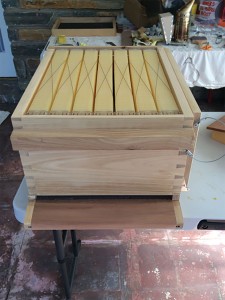
Please bear with me: over 1,000 (no exaggeration) emails from friends, family, colleagues, and “just folks” have clogged my inbox on this topic. Every outreach event for months has featured at least one wide-eyed, hopeful question about “that hive that could save the bees,” and at the DC State Fair, a community gardener told me he ordered the hive because he “wanted bees but did not want to get stung.” I have rolled my eyes, written “the honey is not the thing” replies, and done a slow burn. But I was no better informed than the excitable public that works my nerves. Both of us only watched the ad.
This article is not a product description: if you look up the FAQs, you can learn how the hive is manipulated, how the queen is kept safe, how you can monitor the harvest. But the Indiegogo video most of us refer to is an announcement, not an explanation. And it never claims to save the bees.
Stuart Anderson, co-inventor of the Flow Hive, enthusiastically and graciously responded to this request due to a shared observation: we can help these overwhelmingly urban and suburban beekeepers succeed with something that captured their imagination with hope – the way that CCD did with fear – or we can allow potentially dangerous failures to take place as these folks make mistakes. City beeks: this is coming to us, and it could be really cool. Or not.
Also, the owner of the first Premium Flow Hive in the U.S., Jason Allen-Rouman, allowed me to handle, photograph, and learn about the hive in person. In addition, users of three local bee fora were asked, “What would you ask the inventor of the Flow Hive?” Stuart agreed, with no hesitation, to answer.
The first question, in several variations, was: How can they do something that doesn’t require people to know what is going on in the hive?
And the response is: The Flow Hive does not relieve beekeepers of the responsibility to inspect, understand, and manage the health of their colonies. Stuart Anderson added, “Some will have that impression if they don’t read, and don’t look at our [instructional] videos… we try to get across that you still have to open your hive, to inspect for disease. You need to watch over, get to know your bees, know the health of your colony, and open them to check them out. To do that you need connection to an experienced beekeeper who can point disease, or another condition.”
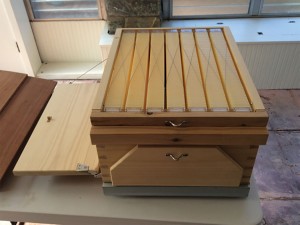
The rear (harvesting) side of a Flow honey super, harvest window closed, observation window open.
“You still need a bee suit or a veil, and you still need to open your hive, you just don’t need to open it as much. Though people with a Flow Hive don’t need to pull [the colony] apart to extract honey, they have to get to know their bees, and the best way to do that is to pull it apart as many times as is recommended in your area. Here [Australia], it’s at least twice: looking out for foul brood, for example, and if disease is going around, I inspect more.”
Your responsibility is to towns and cities as well as the bees: “It’s more than just the health of the bees. My background is community work and I really believe in getting people together. And when people get together over a project, then all sorts of wonderful communications and connections happen, and that strengthens us and our world.”
“This is an enormous opportunity to educate and push bee-related agendas of health for bees and the environment: we certainly have a network, an instant network of beekeepers and potential beekeepers around the world. I’m hoping, I am really hoping, that we can use that well for the health and sustainability of our world. That’s where I come from.”
“The demographic we are reaching is everyone from experienced beekeepers to people without a clue. And so the support, the education, the emphasis on health of the bees, and the interconnectedness of it all is so important.” But also: “People who have bought the Flow Hive are video watchers rather than text readers, so I think more and more videos on identifying disease, and what you watch out for, as well as working with some really interesting developments in in-hive telemetry – you know, sensors and scales – we are working with a couple of companies on that.”
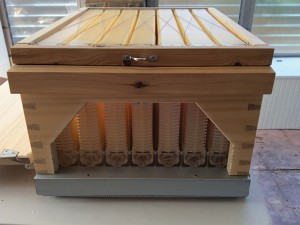
“Unfortunately, with any innovation, with any invention, it will get used for good and bad. That happens. So we emphasize education.”
“I think that [sometimes bees are put in the box and never opened again], too, and it has happened for many years before the Flow Hive. And of course, we have had wild hives forever, just doing what they are doing . . . While we want to put every effort into caring for the bees – and those that can’t care for them should pass them on – we are going to find out how much of a problem it is because as I said, there have been uncared-for hives all around for a long time.”
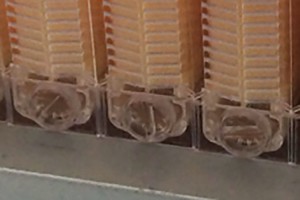
“Ten years ago, beekeepers were saying ‘There’s not enough young beekeepers entering the industry, we are really worried.’ And we know that in terms of pollination and our food supply, it’s commercial beekeepers that make the difference… So we really need people getting excited about bees to the point of becoming commercial and we need to support our commercial beekeepers.” And Anderson stresses that the economics of commercial beekeeping have to improve, too: “When commercial beekeepers have enough funds, then bees are healthy. An example of that is the Manuka honey in New Zealand, the bee industry there is thriving! They are getting such good returns, so there are no worries about bee populations.”
On putting their customers on the path to beekeeping ed, “Perhaps [we can] set up site pages saying ‘watch out, check a few sites, check the prices for bees, connect with a local club, connect up with your local beekeepers, then you’ll be on the right track’… On our community area of the www.honeyflow.com site we have a ‘find a bee club’ interactive app going.” There are also online forums for customer support.
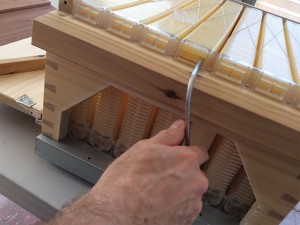
From the rear the beekeeper removes a plastic cap and inserts a (supplied) crank to individually manipulate the desired frame for harvest.
Since many new beekeepers are heading to us, perhaps our local clubs could do this, too. If you are worried about how many Flow Hives will turn up in the hands of wanna-bees near you, how about adding a web page titled “So you Bought a Flow Hive?” with instructions for plugging into the best local knowledge and vendors. Or advertising a talk with one or two of your green partners in the gardening or environmental communities? Viral works more than one way.
Question: Is there an expected life span for the machine? One season, two?
Anderson: “We think dozens, but we don’t know yet. And the plastics companies don’t give that sort of guarantee because they can’t guarantee all the different environments that their plastics are placed in. We know is that the plastic doesn’t degrade unless it is left in the sun, and there is no wear involved in the movement [of the plastic parts] and so we can’t see why it wouldn’t last for 10 or 20 seasons.”
“But if you quote me, it’s all about speculation, because we don’t know. We’ve operated [the hives] five-six times in a row, and that has been fine, hasn’t been any difference. In fact, we have noticed that they work a little bit easier on the second through fourth times than on the first. We think it is because of the way the wax seems to bind initially, deep in the honeycomb. But we don’t know that of course, because it is all brand new.”
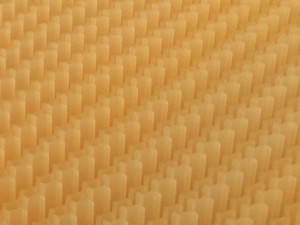
The two rows that make up a cell are not flush at the face of the frame.
Feedback so far: “The Flow Hives got out just in time in June to catch some peoples’ later nectar flow in Europe and the U.S. We got some feedback from a limited number who managed to fill it and that was great. And the feedback was generally positive, with a few questions.”
“There was one person whose honey must have crystallized in the frames, and that’s a chief concern… There are some areas of the States, I know, where the honey will crystallize within three weeks of capping, and that’s an issue. Just like in normal harvesting, you try to extract before it crystallizes, and you do the same in Flow Frames.”
Question: Can small hive beetles and wax moths get into hidden parts where the bees can’t reach them?
Response: “That issue, and particularly Small Hive Beetle (SHB), is of concern to us. I’ve lost hives to SHB and they’re horrible. And so we are well aware of the need to minimize the gaps in which they can hide and to make places where the bees can chase them into whatever trap you’ve got. That’s really important.”
“We’ve tried to design it with no gaps that a bee can’t get into. And we think we have succeeded: however when you put a super of Flow Frames on a hive, you’ve got hundreds and hundreds of little half-formed cells for SHB to dodge into. The bees can still get at them, though, and will keep chasing them. So we haven’t found it to create a niche for SHB, but we’re still open to hear what happens to others. But that has been very important.”
“Wax moths are more of an issue, as I understand it, when storing harvested frames away from the hives.” That is not an issue with Flow Frames. “I haven’t had any problem with wax moths getting into an operating hive.”
In addition: “We’ve got everything you’ve got except Varroa. Most beekeepers [in Australia] are saying ‘It’s not if, but when.’ And we’ve got the beekeeping organizations putting pressure on our government to keep sentinel hives in our ports. We’ll see how we go, but meanwhile we’ve quite a few beekeepers breeding for strength, for hygienic behavior, for varroa, but yeah, it will still catch us out like it has everyone else.”
Customer support
“We have a team of five or six, but sometimes it is up to 10. And we have only just started sending a small number of hives, or Flow Frames, out in June. Now a second batch is going out that is a bit larger. Most emails are concerning enquiries, pre-sales, and customer support is going to be very important. It’s one of the reasons I am pleased that we teamed up with Bee Thinking [in Oregon] to make the [North American] boxes, because that has been their market edge: 80% of their effort, they put into customer support.”
“We have done some work on suggesting that customers subscribe to a beekeeping magazine: in Australia it’s called Australasian Beekeeper, and it’s a great mag. I want that for elsewhere, too – to list all the respectable magazines around the world and get people to hook up to them.”
And their website offers an expanding selection of videos and FAQs for customers and others, as well as a community area with links to outside informational resources and a customer discussion forum.
About the Flow Hive’s development and future
The Flow Hive is the result of a 10-year, father and son labor of love. Stuart says, “It has been very much an invention together – but my son Cedar drove this project – it would have been yet another idea gone by the wayside if it were left to me.”
“It was him pushing, saying, ‘We gotta be able to do this!’ and me thinking, ‘Wow, that is really a tall order!‘ But I couldn’t help but get intrigued and get involved as we started messing around with ideas. Soon I thought, ‘Oh, maybe we can.’”
“But the first ideas were very clunky and clumsy, and we knew we had a long way to go… We were pleased to find that the honey drained out so effectively from those narrow, vertical channels [in the frames]. We were really surprised by that, we expected there would be a lot more honey left behind than there actually is.“
From the first, the company went for the twin goals of high quality construction and holding prices low. The frames are designed to be usable in non-Flow Hives, and future developments are planned as tools that can be put into the hands of ordinary beekeepers. Construction is in Australia and the U.S., not in a lower priced economy.
Looking to the future, along the lines of more bee care with less deconstruction of the hive, sensors may help with identifying disease and monitoring colonies, “I think the big challenge is to get the telemetry cheap, at the moment it is pretty pricey per hive… The technical challenge in getting the information is no problem, meaning the sensors. I think getting it cheap is the challenge.”
“As you probably know, there are a number of beekeepers who believe the best way for bees is actually to leave them completely alone… ‘if they die then they die, but if they live then you have got a strong breed.’ But we have to understand a bit more about disease transmission at the same time in case, for example, a hive gets robbed out.”
“Telemetry is going to give us a lot of information about the movement of disease all around the world, and therefore ways to combat it. Hopefully within five years you’ll be able to get a signal on your smart phone ‘Foul brood in Hive #5’ in your backyard… Not only could you get a warning about your hive, but beekeepers in the area could get a warning. That seems technologically possible.”
In closing
Everyone reading this knows that the history of beekeeping is one of discovery and invention, some of which have changed our relationship with bees, some of which were cockeyed. The idea that one of the most interesting latest inventions results from a decade of work within a family containing generations of beekeepers is comforting. The viral impact this invention had is the part that frightened us. Will people who know nothing kill bees? Will they kill beekeeping? Why do they think a honey harvesting technology will somehow “save the bees?”
Well the latter was never an offer, and many of us could afford to take a look beyond the sexy solicitation video. And after looking, remember that our beekeeping community could use a shot in the arm, and 20,000 of these idealists are coming to a town near you. Millions of people have seen something hopeful about beekeeping, and we can build with hope. We can prepare, welcome them, and succeed, or we can let a lot of failures and even tragedies happen. It’s not that hard to turn idealism into something cool. Look at what these guys did.






